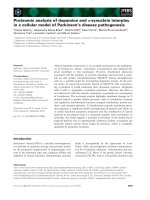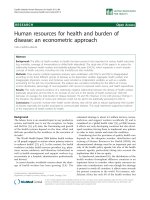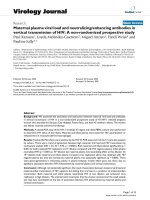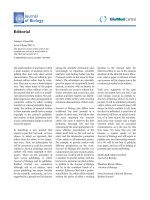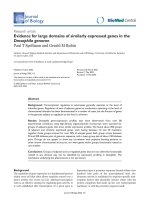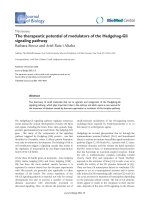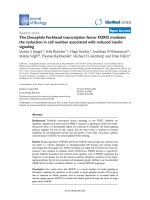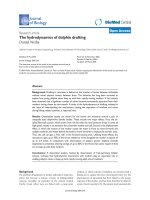Báo cáo sinh học : "The genomic ‘inner fish’ and a regulatory enigma in the vertebrates." docx
Bạn đang xem bản rút gọn của tài liệu. Xem và tải ngay bản đầy đủ của tài liệu tại đây (244.02 KB, 4 trang )
Minireview
TThhee ggeennoommiicc ‘‘iinnnneerr ffiisshh’’ aanndd aa rreegguullaattoorryy eenniiggmmaa iinn tthhee vveerrtteebbrraatteess
John Malone and Brian Oliver
Address: Laboratory of Cellular and Developmental Biology, National Institute of Diabetes and Digestive and Kidney Diseases, Bethesda,
MD 20892, USA.
Correspondence: John Malone. Email: Brian Oliver. Email:
Even before the origin of species by descent from a common
ancestor was posited, it was realized that groups of animals
had related morphologies. Georges Cuvier, the father of
comparative anatomy, viewed anatomical structures though
the lens of form and function. Similar looking anatomical
structures should have similar function, and anatomy could
be used diagnostically to group organisms - a theory he
termed “the correlation of parts” [1]. A famous story
illustrates the idea. One of Cuvier’s students dressed as the
Devil with horns on his head and hoof-shaped shoes burst
into Cuvier’s bedroom when he was asleep and said, “I am
the Devil. I have come to devour you!” Cuvier woke up and
replied, “I doubt whether you can. You have horns and
hooves. You eat only plants.”
The relationship between form and function during evolu-
tion is a classic problem in biology. Yet to fully understand
form and function at the level of anatomy and how those
anatomical features change over time, it is important to
probe the proximate mechanisms that create adult anatomy.
It was therefore only natural that embryology became such
an important tool. Karl Ernst von Baer showed that nearly
all organs and tissues were derived from the same
embryonic layers in practically all animals. This similarity,
an instructional ‘inner fish’, implies that core processes
shared among all vertebrates shape much of ontogeny and
ultimately adult anatomy [2].
DNA sequencing and the understanding that changes in
sequence can also be used to deduce the relatedness of
species marks another important landmark in the history of
science. Conservative and non-conservative changes to
codons have been a boon in understanding the influence of
selection and chance on evolution. The form and function
of vertebrate tissues and organ systems are a thought-
provoking tour of the inner workings of organisms.
Understanding what genes are deployed in a tissue- or
organ-specific manner and across a variety of divergent
species will be as valuable to our understanding of evolu-
tionary processes and will inform us about what parts of the
gene expression networks in an organism of particular
interest, such as humans, have core functionality.
In this issue, Chan et al. [3] dissect the inner workings of
vertebrate tissues and organs with a genomic scalpel and
show that gene-expression profiles of orthologs are correlated.
AAbbssttrraacctt
Information on how genomic information from fish to human encodes the same tissues has
until now emerged one gene at a time. The study published in this issue now provides lists of
genes and their expression levels for 20 vertebrate tissues spanning 450 million years of
vertebrate evolution. It reveals a core set of genes with similar tissue-expression patterns yet
no common regulatory signatures - a gene-expression paradox.
Journal of Biology
2009,
88::
32
Published: 16 April 2009
Journal of Biology
2009,
88::
32 (doi:10.1186/jbiol131)
The electronic version of this article is the complete one and can be
found online at />© 2009 BioMed Central Ltd
These data strongly suggest that both genes and gene-
expression networks are derived from common ancestral
genes and gene-expression networks. While maybe not
surprising, this is important genomic confirmation of what
comparative anatomists and embryologists have long
described and believed. More important, these datasets are
harbingers of the more quantitative and qualitative compre-
hensive description of morphology, a more theoretically
grounded understanding of evolutionary processes that will
follow. As pointed out by the authors, the contribution of
selection and random drift in gene-expression profiles
remains unclear. The theoretical framework for finding
meaning in comparative gene-expression and network
topology data is still in its infancy [4]. These studies will
provide the basis for a revolution in our understanding of
evolution of gene-expression networks that is likely to
thematically recapitulate the study of DNA sequence change
in protein-coding regions.
Chan et al. [3] sampled a range of different tissues, which
should probably become standard in comparative expres-
sion analyses, as not all organs tell the same story. For
example, eyes must be very well adapted, as they show
impressively conserved morphologies within the vertebrates
[5]. Chan et al. show that they also express a set of core
genes that have been highly conserved (Figure 1). As a
counter example, Darwin suggested that sexual selection is
an important driving force in evolution [6], and there are
many studies showing that genes preferentially expressed in
males, and in the testis in particular, are rapidly evolving in
the vertebrates - in frogs [7], birds [8], rodents [9], and
primates [10]. Chan et al. also find that testis gene
expression is rapidly evolving in the vertebrates.
Curiously, they find that the kidney gene-expression profile
may also be rapidly evolving. This could be related to the
changes in water homeostasis in freshwater-dwelling
organisms compared with those that inhabit drier or saltier
environments, and the related excretion of urea or uric acid.
Alternatively, it could be related to the closely linked
embryonic origins and development of gonads and kidneys,
both of which produce products that are passed from the
body. The mesodermal urogenital ridge in the vertebrate
embryo gives rise to both kidney and gonad, and the
development of the kidney and the reproductive tract shows
a remarkable development of functional embryonic neph-
ritic tissue and an array of used, reused, and discarded
plumbing arrangements (for example, Mullerian and Wolf-
fian ducts) that connect the gonad and the kidney to the
outside world [11]. It would be interesting to explore the
idea that fast changes in testis expression profiles drive
changes in the kidney as well.
Given that organs and organ expression profiles are derived
from a common ancestor, one might expect that the
regulation of gene expression should also be conserved.
This is not really terribly different from the idea that similar
organs should express similar genes. The logical idea that
coexpression and co-regulation are linked was one of the
early driving forces behind DNA microarray analysis, but
links between coexpression of batteries of genes and co-
regulation have not been as clearcut as initially expected.
Indeed, Chan et al. [3] make the point that they fail to find
conserved non-genic sequences that are expected to be
driving the core organ-specific expression patterns.
32.2
Journal of Biology
2009, Volume 8, Article 32 Malone and Oliver />Journal of Biology
2009,
88::
32
FFiigguurree 11
((aa))
"Eyes of the world" by Paul Freed. When isolated from other
aspects of head morphology, the remarkable conservation of eye
morphology among animals is striking. Reproduced with permission.
((bb))
Photos of eyes of various vertebrates shown above their gene-
expression profiles. Data taken from Chan
et al.
[3].
(a)
(b)
Fish
Frog
Chicken Mouse
Human
Not finding is a negative result, but if results like this
continue to accumulate, it will be important to fully explore
why. Although it is possible that we are not yet good
enough at finding cis-regulatory sites, this negative result is
becoming a common theme in array studies. Genomic
features with highly conserved functions, such as core
promoters and enhancers, clearly can be swapped between
genes and species (where they function as expected as
judged by the endogenous patterns) but show remarkable
diversity in nucleotide sequence. For example, vertebrate
transgenes expressed in hepatocytes of different species
show similar expression even though the transcription
factor occupancy profiles differ, and divergent enhancers
from different species of Drosophila drive the same patterns
of expression in Drosophila melanogaster embryos [12,13].
Remarkably, there have been natural wholesale exchanges
of regulatory sequences to drive the expression of highly
conserved ribosomal protein encoding genes in yeasts [14],
suggesting that different transcription factors can coregulate
large groups of genes in different species. It is beginning to
look as if there is a more profound explanation than
technical limitations for our inability to find conserved cis-
regulatory patterns among orthologs with similar
expression patterns. Maybe conservation in cis-regulatory
regions is difficult to find because they are highly malleable
and transient.
It is perhaps worthwhile to step back and think about the
unit of selection. For an animal to reproduce and pass on its
genome, it needs to develop and use organs and organ
systems. We know that early errors in organ development
are catastrophic for adult viability and reproductive success.
So, intuitively, the initial steps in a genetic pathway or the
first committed step in a series of enzymatic reactions must
be critical, but this is only true if there are few ways to
generate a pattern or product. If there are multiple mecha-
nisms, how an organism bootstraps to an acceptable
outcome is less important. In a ‘Christmas tree’ model of
evolution, this represents changing the branches on which
ornaments are placed while maintaining the same
/>Journal of Biology
2009, Volume 8, Article 32 Malone and Oliver 32.3
Journal of Biology
2009,
88::
32
FFiigguurree 22
The conservation of transcription factor production and target gene expression in a given cell type. This cartoon representation shows such
conservation of gene expression driven by a lineage-specific arrangement of bound transcription factors (colored ovals). The arrow indicates gene
expression. The factors expressed in the ancestral cell can be inferred, but the
cis
-regulatory arrangement cannot.
? ?
Ancestral cell
Gene A
Gene A
decorative appearance [15]. Sexual reproduction is a good
example of this model. Sex results in remarkably similar
gametes in a wide range of species, but the genetic pathways
that govern the early steps of sex differentiation show
astounding differences in theme and gene [16]. The
malleability of sexual mode can be seen in the nematodes,
where hermaphrodite and separate sexes have evolved
multiple times using different underlying mechanisms, and
within Caenorhabditis elegans the prime sex-determination
signal can be experimentally switched from chromosomal
to temperature [17].
If the females and males of the same species can be built
using such different basal genetic hierarchies while main-
taining the expression of critical well-adapted ‘terminal’
functions like sperm and eggs, then maybe organ gene-
expression patterns can also be maintained with different
underlying sets of transcription factors. This really boils
down to asking how many solutions exist for a given
expression pattern problem. If more than 10% of genes in a
genome encode transcription factors and some substantial
fraction of those genes are expressed in a given cell type,
then there may be many ways to achieve the same
transcriptional output. In these circumstances, a rather fluid
exchange of regulatory mechanisms might be expected
during the evolution of the vertebrates (Figure 2). De novo
evolution of transcription factor binding sites should be
relatively simple as these are short (usually less than 10 base
pairs) and degenerate. The combination of conserved factor
function and site turnover might result in multiple
functionally equivalent cis-regulatory elements. Indeed, the
exchange of one cis-regulatory sequence for another can
occasionally be spotted [18]. If this proves to be generally
true, then the implications for evolution and for using
phylogeny to discover cis-regulatory regions are significant.
Since Cuvier, careful cataloging of anatomy in the context of
phylogeny and development has had a major impact on our
understanding of how living organisms evolve. While there
are occasional examples of convergent evolution that has,
for example, resulted in wings and thermal homeostasis in
both mammals and birds, the vast bulk of comparative
anatomy data reveals the deep roots of tissues and organ
systems. Morphology indicates that the basic sensory,
digestive, reproductive and excretory functions in animals
are conserved. Although we do not have a rigorous
understanding of the role of selection and drift in the
evolution of gene expression, form and function has
probably required the conservation of much of the core
organ-specific expression network in the vertebrates. The
lack of a relationship between coexpression and co-
regulation at evolutionary timescales indicates that either
we still do not understand how to find cis-regulatory
modules, or time has erased the vestiges of the
intermediates in the vertebrates sampled.
RReeffeerreenncceess
1. Coleman W:
Georges Cuvier, Zoologist: A Study in the History of
Evolution Theory.
Cambridge: Harvard University Press; 1964.
2. Shubin N:
Your Inner Fish.
New York: Pantheon Books; 2008.
3. Chan ET, Quon GT, Chua G, Babak T, Trochesset M, Zirngibl R,
Aubin J, Ratcliffe M, Wilde W, Brudno M, Morris QD, Hughes TR:
CCoonnsseerrvvaattiioonn ooff ggeennee eexxpprreessssiioonn iinn vveerrtteebbrraattee ttiissssuueess
J Biol
2009,
88::
33.
4. Lynch M:
TThhee eevvoolluuttiioonn ooff ggeenneettiicc nneettwwoorrkkss bbyy nnoonn aaddaappttiivvee
pprroocceesssseess
Nat Rev Genet
2007,
88::
803-813.
5. Lamb TD, Collin SP, Pugh EN Jr:
EEvvoolluuttiioonn ooff tthhee vveerrtteebbrraattee eeyyee::
ooppssiinnss,, pphhoottoorreecceeppttoorrss,, rreettiinnaa aanndd eeyyee ccuupp
Nat Rev Neurosci
2007,
88::
960-976.
6. Darwin C:
The Descent of Man, and Selection in Relation to Sex.
London: John Murray; 1871.
7. Malone JH, Hawkins DL Jr, Michalak P:
SSeexx bbiiaasseedd ggeennee eexxpprreessssiioonn
iinn aa ZZWW sseexx ddeetteerrmmiinnaattiioonn ssyysstteemm
J Mol Evol
2006,
6633::
427-436.
8. Mank JE, Hultin-Rosenberg L, Webster MT, Ellegren H:
TThhee uunniiqquuee
ggeennoommiicc pprrooppeerrttiieess ooff sseexx bbiiaasseedd ggeenneess:: iinnssiigghhttss ffrroomm aavviiaann
mmiiccrrooaarrrraayy ddaattaa
BMC Genomics
2008,
99
:148.
9. Turner LM, Chuong EB, Hoekstra HE:
CCoommppaarraattiivvee aannaallyyssiiss ooff
tteessttiiss pprrootteeiinn eevvoolluuttiioonn iinn rrooddeennttss
Genetics
2008,
117799::
2075-2089.
10. Khaitovich P, Hellmann I, Enard W, Nowick K, Leinweber M, Franz
H, Weiss G, Lachmann M, Paabo S:
PPaarraalllleell ppaatttteerrnnss ooff eevvoolluuttiioonn iinn
tthhee ggeennoommeess aanndd ttrraannssccrriippttoommeess ooff hhuummaannss aanndd cchhiimmppaannzzeeeess
Science
2005,
330099::
1850-1854.
11. Wagner GP, Lynch VJ:
MMoolleeccuullaarr eevvoolluuttiioonn ooff eevvoolluuttiioonnaarryy nnoovveell
ttiieess:: tthhee vvaaggiinnaa aanndd uutteerruuss ooff tthheerriiaann mmaammmmaallss
J Exp Zool B Mol
Dev Evol
2005,
330044::
580-592.
12. Fisher S, Grice EA, Vinton RM, Bessling SL, McCallion AS:
CCoonnsseerr
vvaattiioonn ooff RREETT rreegguullaattoorryy ffuunnccttiioonn ffrroomm hhuummaann ttoo zzeebbrraaffiisshh wwiitthhoouutt
sseeqquueennccee ssiimmiillaarriittyy
Science
2006,
331122::
276-279.
13. Ludwig MZ, Patel NH, Kreitman M:
FFuunnccttiioonnaall aannaallyyssiiss ooff
eevvee
ssttrriippee 22 eennhhaanncceerr eevvoolluuttiioonn iinn
DDrroossoopphhiillaa
:: rruulleess ggoovveerrnniinngg ccoonnsseerr
vvaattiioonn aanndd cchhaannggee
Development
1998,
112255::
949-958.
14. Tanay A, Regev A, Shamir R:
CCoonnsseerrvvaattiioonn aanndd eevvoollvvaabbiilliittyy iinn rreegguu
llaattoorryy nneettwwoorrkkss:: tthhee eevvoolluuttiioonn ooff rriibboossoommaall rreegguullaattiioonn iinn yyeeaasstt
Proc Natl Acad Sci USA
2005,
110022::
7203-7208.
15. Wagner GP, Lynch VJ:
TThhee ggeennee rreegguullaattoorryy llooggiicc ooff ttrraannssccrriippttiioonn
ffaaccttoorr eevvoolluuttiioonn
Trends Ecol Evol
2008,
2233::
377-385.
16. Wilkins AS:
MMoovviinngg uupp tthhee hhiieerraarrcchhyy:: aa hhyyppootthheessiiss oonn tthhee eevvoolluu
ttiioonn ooff aa ggeenneettiicc sseexx ddeetteerrmmiinnaattiioonn ppaatthhwwaayy
BioEssays
1995,
1177::
71-77.
17. Haag ES:
TThhee eevvoolluuttiioonn ooff nneemmaattooddee sseexx ddeetteerrmmiinnaattiioonn::
CC eelleeggaannss
aass aa rreeffeerreennccee ppooiinntt ffoorr ccoommppaarraattiivvee bbiioollooggyy
WormBook
2005,
1-14
18. Ihmels J, Bergmann S, Gerami-Nejad M, Yanai I, McClellan M,
Berman J, Barkai N:
RReewwiirriinngg ooff tthhee yyeeaasstt ttrraannssccrriippttiioonnaall nneettwwoorrkk
tthhrroouugghh tthhee eevvoolluuttiioonn ooff mmoottiiff uussaaggee
Science
2005,
330099::
938-940.
32.4
Journal of Biology
2009, Volume 8, Article 32 Malone and Oliver />Journal of Biology
2009,
88::
32
